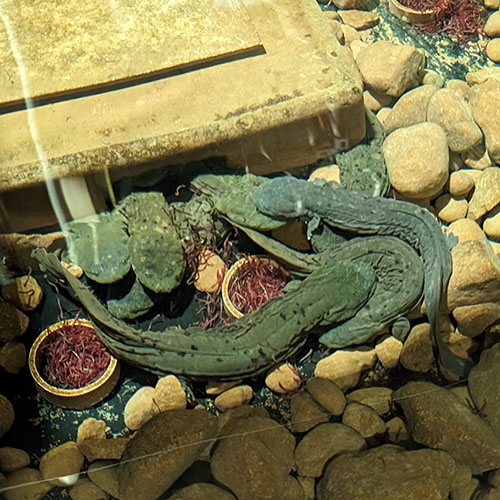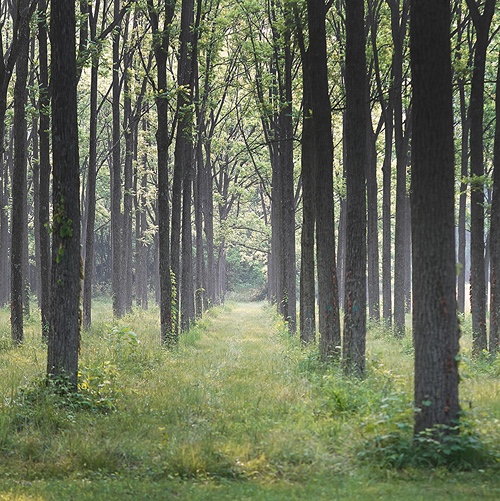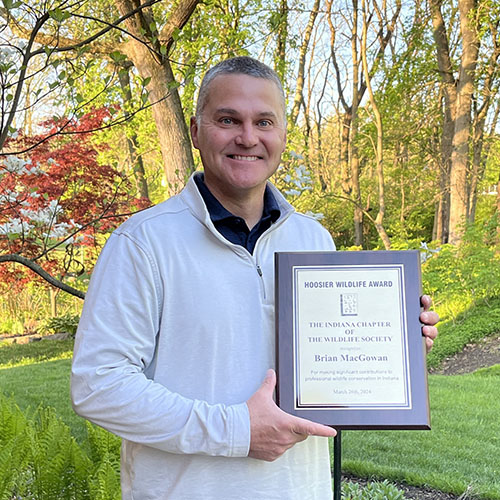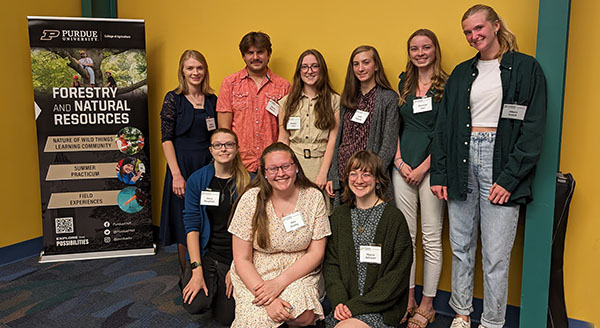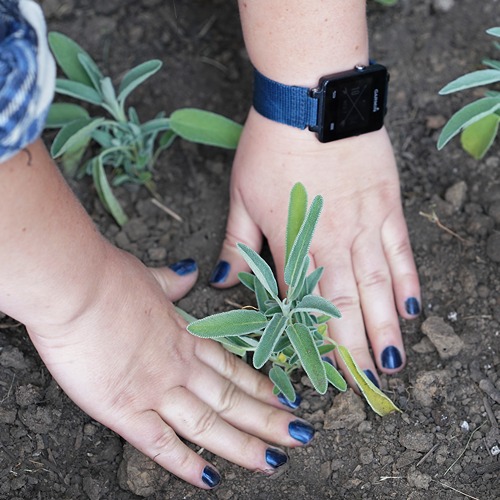“Don’t be afraid to try new things and follow your passions. Give yourself some space to explore and try new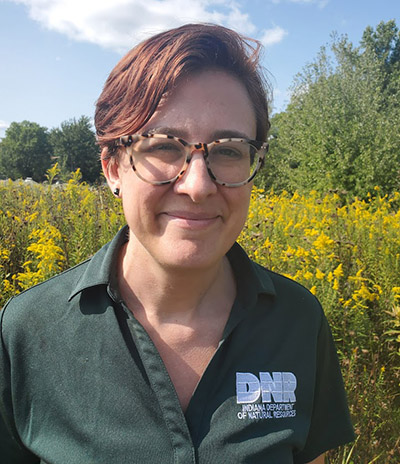 things because that is how you are going to learn what you love.” – Emily McCallen, 2023 Chase S. Osborn Award for Wildlife Conservation, Early Career Award; PhD 2018.
things because that is how you are going to learn what you love.” – Emily McCallen, 2023 Chase S. Osborn Award for Wildlife Conservation, Early Career Award; PhD 2018.
Emily McCallen grew up outdoors, watching wildlife, camping and hiking, but her path to a career in the natural resources field was unconventional.
The Belvidere, Illinois, native said that although there were signs early on that she was interested in biology, her career ambitions were more in the arts.
“My favorite place to be when I was a kid was out in the garden barefoot, and that is still my favorite place to be,” McCallen explained. “I was kind of a day dreamer. Academically I wasn’t super ambitious. I liked to read a lot and I always thought I would grow up to be an author. I wanted to write, and I guess in some ways I do that now through science communication. But, I do remember, when I was growing up, my dad was a meat cutter and during deer season he would process deer in the garage to earn extra money. My sister thought it was so disgusting, but I remember thinking it was really cool that you could see all of the muscles, etc. I also took some class in high school that got me interested in environmental science, but even then I didn’t think that was a career path I was going to go down.”
McCallen went to liberal arts college, but only stayed for a year because she “didn’t find anything that really felt like a good fit for me.” She took time off and went to work in retail. Time passed and McCallen met her husband and the pair made the decision to go back to school, beginning at Rock Valley College.
“I realized that working in retail wasn’t what I wanted to do forever and I thought there was something else out there for me,” McCallen recalled. “But, going back to school was scary. I remember feeling really scared about going to my first class, but, as soon as I got there, I realized I was actually interested. I think in the gap of time while I was working, I missed being in an environment where I was thinking about new things and learning new things. I very quickly realized that I was happy to be back in school. Then, I took my first biology class and thought ‘wow, this is really cool. I don’t know what you can do with this, or what a potential career path is, but I really like this.”
After finishing an associate degree at Rock Valley, McCallen went on to study environmental biology with a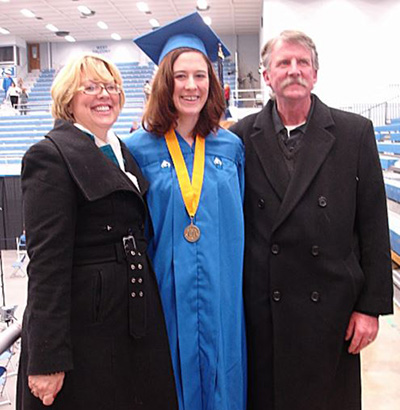 geographic information sciences minor at Eastern Illinois University. Her time at EIU provided several seminal experiences that set her on the path to her current career in natural resources.
geographic information sciences minor at Eastern Illinois University. Her time at EIU provided several seminal experiences that set her on the path to her current career in natural resources.
“I took my first GIS class at EIU and I found that was a passion as well,” McCallen said. “I thought it was really cool, especially the intersection of GIS and biology, so I started going down that path a little more. I took my first animal behavior class with entomologist Paul Switzer and we did a research project. That was the first time I had ever experienced the active process of doing science as opposed to just learning about science and that was huge for me. I thought, this is something I would like to keep doing.
“Luckily, I was able to keep working in his lab and that was when I got my first real taste for an independent research project. One of his master’s students was working on Japanese beetles and I was able to do a project off of her project, looking at how different land use patterns affected abundance in the soybean fields we were sampling. It was not the most fun field experience picking off beetles, but it gave me my first practical field experience and it was a cool opportunity as an undergrad.”
While her husband was completing his teaching degree at EIU, McCallen began working with Dr. Karen Gaines, a 1994 Purdue master’s alumna, who was the chair for biological sciences at EIU.
“I had some classes with Dr. Gaines as an undergrad, including spatial ecology, and we got along very well,” McCallen said. “She was doing really cool stuff at the intersection of GIS and ecology. I knew that was something I was interested in, so I approached her and asked if she had anything that I could work on for a master’s project. Karen was a great mentor, because I was pretty young and didn’t have a lot of practical experience. She could sense when I needed hands-on help versus when I needed to try things on my own, and when I needed empathy versus accountability. Now that I’m spending more time mentoring people in a formal way, I think back to the way that she did it.”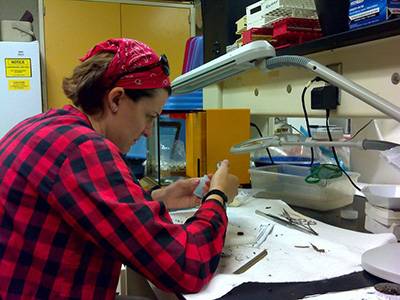
Gaines had been doing research at the site of the Savannah River site of the Savannah River National Laboratory in South Carolina, a Department of Energy site where weapons grade processing of nuclear material had taken place in the past. The project developed an environmental risk assessment for river otters on that site, estimating their exposure to heavy metals and radio nuclides, based on what areas they were using at the site.
“The Savannah River site is a very cool site ecologically,” McCallen explained. “Other researchers had done environmental risk assessments, but we were bringing in this habitat piece, predicting what we thought their exposure would be like based on the habitats they were actually using on the site. Most of the data had already been collected for developing the models, but we got to go back to the site and collect scat for validating those models. It was a very cool project, but it was also the last time my husband ever agreed to be my field assistant.”
While at EIU, McCallen also was a graduate teaching assistant for several courses ranging from general biology to animal diversity and a lab instructor for biological principles and issues. She also worked with her husband one summer to develop a science curriculum for elementary school children, sparking an interest in outreach.
As fate would have it, Dr. Rod Williams, professor of wildlife science at Purdue, gave a seminar for the graduate students at EIU discussing the outreach efforts he was doing for both eastern hellbender research and the Nature of Teaching curriculum program. After the seminar, Williams, a three-time Purdue alumnus (BS 1996, MS 1998, PhD 2007), mentioned that he and Dr. Songlin Fei were looking for a graduate student to do habitat modeling for hellbenders in the Blue River.
“I thought the outreach and extension work that he was doing was really cool,” McCallen said. “And, coming from the project that I was doing at Eastern Illinois, the research seemed like it was a really good fit and good timing. I have talked about serendipity and not planning too far ahead. Well, I really had no intention of getting a PhD and I thought it was a little bit crazy, but then I talked to my husband about it. It was just too good of an opportunity to pass up. I was still enjoying school and enjoying doing the work, I thought it would be cool to jump into this project, especially with the species. Hellbenders are just undeniably the coolest herp species. It also felt like a move up from working with otter poop to actually being able to work with hellbenders. It was an easy choice. You are going to be in your career forever, so you need to put your energy where your passion is so you don’t burn out, even when it doesn’t always seem like it is practical.”
Although the work was on a topic that intrigued her, the road to completing her doctorate was not an easy one for McCallen.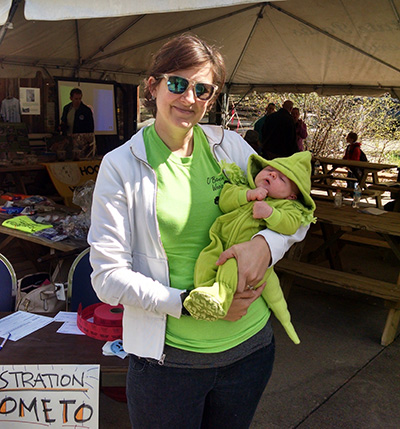
“My PhD was a very challenging time,” McCallen recalled. “During my second year, I had my son and, because of that, my project went from being a very field-based project to more of a theoretical modeling project. Then, we found out that my son had lead poisoning because the old house that we were living in had chipping lead paint. We had to remediate the house and that was another big thing that we had to deal with all of a sudden. When I look back on my time at Purdue, I made so many lifelong friends, but I just remember being exhausted. Between having a newborn, dealing with the house and trying to effectively make progress on my dissertation, it was an awful lot. It was a learning experience and I found out that I had a lot more strength than I knew I had.”
Working with Williams on the hellbender project allowed McCallen to be part of conservation efforts involving the state endangered eastern hellbender that continue to this day.
“I made a lot of really good friends in that lab, because we spent a lot of time down in the Blue River together, freezing our butts off looking for nests and looking for benders,” McCallen said. “My first summer I did a lot of telemetry out there. It’s a really beautiful area of Indiana and it is really cool because we are keeping an endangered species going there. There is a lot of really cool science coming out of that lab. I am proud to be a part of that science, especially in terms of how we can change and alter captive rearing to affect the survival of those animals on the landscape. One of the things I really like about my job is that I am able to continue to be involved in that project. I was out there helping with larval surveys the day we found the baby hellbender this summer. That was probably the happiest day of fieldwork I have ever had. It was just an amazing feeling to see years and years of work leading up to us hitting that conservation milestone.”
The research produced publications on “Evaluating the Survival of Translocated Adult and Captive-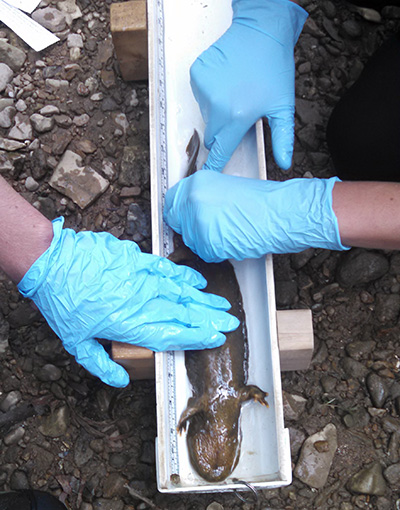 Reared, Juvenile Eastern Hellbenders” and on “Movement and Habitat Use in Eastern Hellbenders Following Population Augmentation.” McCallen’s dissertation was titled “Spatial Genetic and Distribution Modeling for the Conservation of Hellbender Salamanders.”
Reared, Juvenile Eastern Hellbenders” and on “Movement and Habitat Use in Eastern Hellbenders Following Population Augmentation.” McCallen’s dissertation was titled “Spatial Genetic and Distribution Modeling for the Conservation of Hellbender Salamanders.”
The other side of McCallen’s research at Purdue, under Dr. Songlin Fei, resulted in a publication titled “Trends in Ecology: Shifts in Ecological Research Themes over the Past Four Decades.”
“Songlin does a very different type of work, but he helped me a lot with the modeling pieces,” McCallen said. “He is also awesome in terms of creating a really collaborative lab environment. I think probably the most impactful paper I have that came out of his lab was from all of us doing a group project together. It was just a side project, but he encouraged it as a way for us all to work together. I think it is impactful because it is not just about one species, it is about the field of ecology overall. We used automated content analysis to look at trends and ecological papers over 40 years, looking at the abstracts of more than 80,000 papers to develop those themes. That was my first taste of a truly collaborative group project.”
“I think one of the reasons that Songlin is a fabulous scientist is that he is really good at telling a story and creating a narrative in his publications. He taught me that it doesn’t matter how good your science is, if you can’t communicate that to people, it is not going to go anywhere.”
After graduating from Purdue with her PhD in 2018, McCallen stepped into her current role as a wildlife biometrician with the Indiana Department of Natural Resources Division of Fish & Wildlife (DFW). In that role, she assists the biologists who manage wildlife species in Indiana at DFW, as well as external researchers, with everything from project design to ensuring proper data collection, running code or statistics and co-authoring manuscripts and reports.
biometrician with the Indiana Department of Natural Resources Division of Fish & Wildlife (DFW). In that role, she assists the biologists who manage wildlife species in Indiana at DFW, as well as external researchers, with everything from project design to ensuring proper data collection, running code or statistics and co-authoring manuscripts and reports.
“My job is never boring,” McCallen stated. “There is always something new to work on, something new to learn about. For a data nerd, for someone who loves getting in and playing with data, this job is awesome. I remember when I saw the job description, I said, ‘Oh, the DNR put a job together for me.’ It seemed like such a perfect fit, and, so far, that has really been the case.”
Since January 2020, McCallen’s work has shifted to focus more on game species, but that has allowed her to be involved with several impactful projects.
A collaboration with 2020 Chase S. Osborn Award in Wildlife Conservation recipient Steve Backs resulted in two publications, “The Restoration and Population Status of Eastern Wild Turkeys in Indiana” and “50 Years of Spring Wild Turkey Harvest in Indiana, 1970-2019.”
“I was lucky enough to work with Steve towards the end of his career and on two really important publications that he saw as capstones on what he was doing,” McCallen said. “We put together a paper on the history of turkey restoration in Indiana. We are so far removed from those restorations, but there are several species in Indiana that were completely extirpated and then restored. They have come back so well that we are actually able to harvest them now. Celebrating those wins and getting their history into a scientific publication was really important and I was really glad we were able to do that.
“Then, we were able to look at 50 years of harvest data at a county by county level and see what the trends were. Being able to look at that over time and really try to do science-based management of the species, I was really happy with that work. When I can work with a biologist who has a really deep knowledge and understanding of the system and then bring the statistical backbone to those papers, I think those are the best kind of collaborations.”
In addition to assisting researchers and biologists with their projects, McCallen is tasked with ensuring that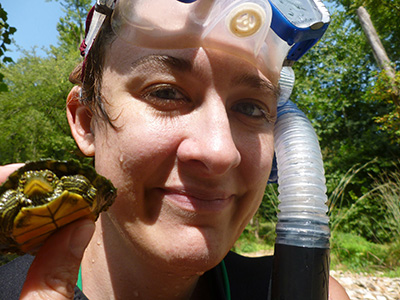 the data collected via monitoring of various wildlife populations is turned around for public facing accessibility.
the data collected via monitoring of various wildlife populations is turned around for public facing accessibility.
“At the end of the day, we work for the public. When we are collecting data, it isn’t just going into a black hole, we are developing a lot of dashboards and creating web-based applications and databases that the public can interact with,” McCallen said. “We are making sure that the data we collect is as good as it can be and that we are presenting it back to the public with as much statistical rigor as possible.”
McCallen’s work has been honored internally by the Indiana Department of Natural Resources three times since 2021. First, she was a recipient of the Fish & Wildlife Director’s Team of the Year Award in 2022 for her work on a project looking at the historic, geographic and economic perspectives of recreational fishing, hunting and trapping license fees in Indiana.
“We had not raised our license prices in Indiana since 2006, which meant we were really limiting the amount of conservation work that we could do on the ground because those fees hadn’t followed inflation,” McCallen explained. “We took a big step back and looked at the overall pattern of how license fees had increased in surrounding states. We looked at where our license prices would be if they had followed inflation and where they should be priced based on supply and demand. Based on our economic demand models and other analysis we were able to raise prices and that was a huge win for our division.”
Her work on the licensing project and a few other projects earned McCallen the Fish & Wildlife Champion Award, which is given to one biologist or program manager to recognize their outstanding contributions to fish and wildlife conservation.
McCallen works with a volunteer monitoring system, which offers the public a place to report sick or dead wildlife, and allows the Division of Fish and Wildlife to track those over time and possibly predict future mortality events. She also was responsible for the building and maintenance of the turkey brood reporting system and mammal reporting system.
McCallen also developed a population reconstruction model for the river otter, using age, harvest numbers and hunter efforts to estimate the annual population size to ensure the species is being harvested sustainably in the state.
In 2023, McCallen was part of a team that developed an electronic survey to gather information from anglers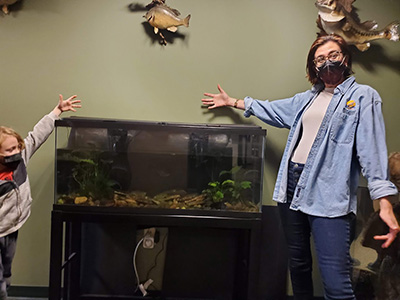 about their opinions on fisheries management throughout the state and individual water bodies. McCallen and her collaborators earned a DFW Team of the Year Award for their work.
about their opinions on fisheries management throughout the state and individual water bodies. McCallen and her collaborators earned a DFW Team of the Year Award for their work.
“Previously we had done licensed angler surveys, but we always contracted them out and we didn’t get the raw data,” McCallen said. “Without that data, it is hard to track minor changes over time and direct the responses to our management actions. By developing this survey in house, we have more frequent access to the data and can turn it around very quickly so that the public can interact with that data.
“Amanda Wuestefeld (BS Wildlife 1996), director of the Division of Fish and Wildlife, really pushes us to be leaders as an agency. It can be challenging, but it is exciting to work somewhere they are open to trying new things, embracing technology and trying to make things better. We have an awesome collaborative environment. I couldn’t do everything that I do without the awesome people that I work with. I am grateful to have found a position that is energizing, where I am excited to get to work on projects every day that feel meaningful and impactful.”
Currently, McCallen is working on a handful of standout projects ranging from a northern bobwhite project at Goose Pond Fish and Wildlife Area to the expansion of the Fish & Wildlife One Health program to the implementation of the Indiana Science, Policy, Education and Career Training program.
The nearly $900,000 northern bobwhite project is a collaborative effort between the Indiana DNR, the James Martin Lab at the University of Georgia and the property managers at Goose Pond, looking at the effects of harvest and habitat condition on northern bobwhite.
“Researchers spent the first three years looking at the current harvest regulations in Indiana,” McCallen explained. “The next three years of the study are actually adjusting some of those harvest quotients to see how populations response to those changes. We are also using acoustic recording units in areas where we are working with private landowners on Conservation Reserve Program (CRP) projects. We will take those acoustic recordings and use them to see changes in abundance or occupancy of our grassland species in those areas. I think both of those are really cool projects because they are science-based management in action.”
McCallen is part of a more than $750,000 grant led by Dr. Michelle Benavidez Westrich, the Fish & Wildlife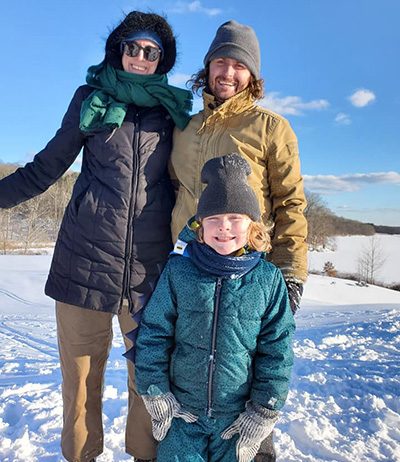 health supervisor, focusing on fostering a sustainable wildlife health program with a One Health focus in Indiana.
health supervisor, focusing on fostering a sustainable wildlife health program with a One Health focus in Indiana.
“Healthy ecosystems, healthy wildlife and healthy humans all have to interact together, so we are going to conduct a gap analysis to figure out areas of improvement, in order to create official guidelines and processes for how the health program responds to official wildlife health events,” McCallen said. “The two pieces that I am heavily involved in are increasing our capacity on the data side and also in bringing all the data together to create a dashboard for our internal stakeholders that will allow us to see what is happening on the ground. Tying all of our systems together, both the samples that we are taking of sick and diseased wildlife and also the wildlife reports that we are receiving through our reporting systems, will allow us to see early when a wildlife mortality event is happening and respond to it quickly.”
As part of the One Health project, McCallen is involved in the design of projects ranging from how heavy metal contamination in watersheds affects avian influenza viral loads and infections in waterfowl, to a project that aims to get a baseline of viral communities in bats.
A new project called the Indiana Science, Policy, Education and Career Training (INSPECT) program, is a collaboration between the Indiana Academy of Sciences and several colleges and agencies within the state.
“It is a fellowship program for PhD students, where they go and work in an agency and either do a project or become directly involved in how policy is happening so that they can learn about it and act as scientific advisors,” McCallen said. “We had our first INPSECT fellow at DFW this year and it was a really cool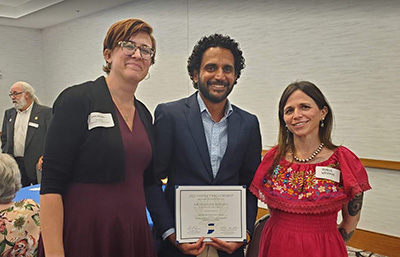 experience. We have all of these data sources and they have all of these students that want to learn and work with data. This project has allowed me to have a little more of a mentorship and teaching role as the students learn from the data and help me make it more readily accessible for the public.”
experience. We have all of these data sources and they have all of these students that want to learn and work with data. This project has allowed me to have a little more of a mentorship and teaching role as the students learn from the data and help me make it more readily accessible for the public.”
The Chase S. Osborn Award in Wildlife Conservation, is presented by Purdue Forestry and Natural Resources to an individual who, by writing, research, teaching or other personal accomplishments has made significant contributions to wildlife conservation in the state of Indiana.
McCallen received the Chase S. Osborn Early Career Award from Dr. Rod Williams at a ceremony on Sept. 8. 2023.
“Emily’s deep understanding of population modeling is an invaluable tool for the hellbender conservation program,” Williams said. “She collaborates with my lab on all reintroduction projects, helping us determine post-release juvenile survival, and thus, the efficacy of our captive rearing research. I couldn’t be more delighted she is being recognized for her efforts with hellbenders and wildlife in general.”
For her part, McCallen is thankful for everything and everyone that has gotten her to this point in her career.
“My time at Purdue was amazing,” McCallen said. “I got to work with a lot of people while I was there as a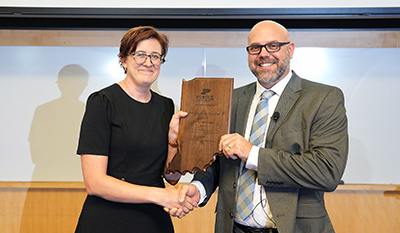 grad student and I feel really lucky that I get to work with those people now here in my capacity as a biometrician. To have the work that I'm doing here in Indiana acknowledged and honored by the same people I worked with in FNR feels like a huge honor and a bit overwhelming, but I am so grateful. I love the fact that we are building these strong relationships and I am excited to see what is going to happen next. I foresee us doing good science together for a long time and I am really excited for those opportunities.”
grad student and I feel really lucky that I get to work with those people now here in my capacity as a biometrician. To have the work that I'm doing here in Indiana acknowledged and honored by the same people I worked with in FNR feels like a huge honor and a bit overwhelming, but I am so grateful. I love the fact that we are building these strong relationships and I am excited to see what is going to happen next. I foresee us doing good science together for a long time and I am really excited for those opportunities.”
As she moves forward into the rest of what will surely be a successful and fulfilling career, McCallen offered advice to current and future natural resource professionals.
“It always pays to invest in learning how to communicate more clearly and learning how to build those narrative structures to tell your story,” McCallen shared. “It doesn’t matter where you go in the future, being able to do that is going to make you better at your job. Second, perfectionism is your worst enemy. Sometimes in grad school I had trouble get started on things that were really important because I was secretly afraid that I couldn’t do it or couldn’t do it perfectly. You have to give that up and just start trying. And finally, don’t be too rigid with your plans. Don’t be afraid to try new things and follow your passions. Give yourself some space to explore and try new things because that is how you are going to learn what you love.”
